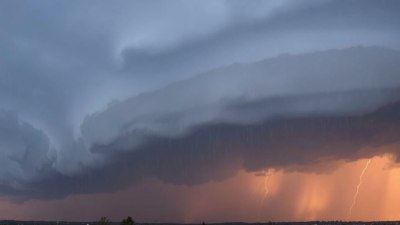How a Warm Front Brings a Slow, Lingering Rain
Explore how warm fronts cause slow, persistent rain through atmospheric processes and weather patterns.

Warm fronts are fundamental features in meteorology associated with specific weather changes, particularly slow, lingering rain. Understanding how a warm front brings such rain requires delving into atmospheric dynamics and the interactions between different air masses. This article explores the meteorological processes behind warm fronts and the resulting weather patterns.
At its core, a warm front occurs when a warmer air mass slides over a cold air mass. Because warm air is less dense than cold air, it does not displace the colder air abruptly but rises gently above it. This gradual ascent leads to widespread cloud formation and prolonged precipitation, typically characterized by steady, slow rain that persists for hours or even days.
The classic visualization of a warm front on weather maps is a red line with semicircles pointing in the direction of movement. This symbol indicates the boundary where warm air advances, overriding the retreating cold air. Behind the front, temperatures rise gradually as the warm air mass moves in, but ahead of the front, cool, moist conditions are common.
When warm air slides up over the cold air, it cools as it rises, leading to condensation if sufficient moisture is present. The lifting mechanism here is gentle, which is a key difference from cold fronts where warm air is forced up more abruptly, triggering intense thunderstorms and heavy rain. In the case of warm fronts, the slow ascent results in the formation of stratiform clouds—layers of clouds such as stratus and nimbostratus that cover large areas uniformly.
These layered clouds are responsible for the consistent, steady precipitation associated with warm fronts. Unlike the short, intense showers from cumulonimbus clouds in cold fronts, warm front precipitation tends to be light to moderate but continuous. This can lead to fog, drizzle, and long-lasting rain showers spread over a broad region.
The vertical structure of the atmosphere also plays an important role. Warm fronts are often accompanied by a warm air wedge ascending over the colder air below. This wedge-shaped zone creates a thick cloud cover that extends several kilometers upward. The cloud layers thicken and descend over time as the front approaches, giving rise to low clouds and persistent rain near and ahead of the frontal boundary.
The humidity profile preceding a warm front is typically high. Warm air masses arriving from tropical or subtropical regions contain abundant moisture. As this moist air rises and cools above the colder air, condensation occurs along the front’s leading edge. This moisture source is essential for the sustained precipitation.
Moreover, orographic features such as mountains can enhance warm front precipitation. When the gently sloping warm air is forced upward by terrain, additional lifting occurs, intensifying rain in those areas. This results in wetter conditions along windward slopes where fronts pass.
Another aspect to consider is the speed of the front. Warm fronts generally move slower compared to cold fronts. Their gradual progression allows extended periods of rain because the rain-producing cloud mass remains over the same area longer. In contrast, rapidly moving fronts bring brief but often more intense precipitation events.
The slow movement and layering of clouds in warm fronts produce a characteristic sequence of weather changes. Initially, high cirrus clouds appear ahead of the front, followed by thicker cirrostratus and altostratus clouds as it approaches. Eventually, nimbostratus clouds arrive, bringing steady precipitation. After the front passes, the sky often clears, and temperatures rise as the warm air mass fully occupies the region.
Wind patterns also shift with the passage of a warm front. Typically, winds ahead of the front blow from the east or southeast, bringing moisture-laden air, while behind the front, winds shift to the south or southwest, indicating warmer conditions. The gentle wind changes contribute to the gradual weather transition associated with warm fronts.
One notable phenomenon linked to warm fronts is the development of widespread fog and low visibility ahead of the front. This occurs as moist warm air moves over the cooler surface, leading to saturation and fog formation. This can impact transportation and daily activities until the front passes and conditions improve.
In regions with distinct seasonal patterns, warm fronts can signal important weather shifts. For example, during spring, the intrusion of warm fronts is associated with the transition from cold winter conditions to milder, wetter weather as warmer air masses become dominant. Similarly, in fall, warm fronts may usher in a temporary warm spell amidst cooler surroundings.
The impact of warm fronts extends beyond the rain itself. Persistent rain events influence soil moisture, river flows, and local ecosystems. Extended periods of precipitation can replenish water supplies but also contribute to flooding if the rain is intense or prolonged over saturated ground.
Meteorologists utilize various tools to track and forecast warm fronts and their associated rain. Satellite imagery provides visual cues of cloud layering and motion, while radar detects precipitation intensity and distribution. Surface observations give data on temperature, humidity, and wind changes signaling front passage.
Numerical weather prediction models simulate the approach and progression of warm fronts by incorporating atmospheric physics and moisture dynamics. Forecasts derived from these models help predict the onset, duration, and intensity of the rain associated with warm fronts, enabling preparations for potential weather impacts.
In summary, the slow, lingering rain characteristic of warm fronts stems from the gentle ascent of warm, moist air over cooler air masses creating layered clouds and steady precipitation. The gradual nature of this process results in extensive rain coverage and extended wet periods. This contrasts vividly with the rapid, often intense rain from cold fronts and underscores the complexity of atmospheric processes determining regional weather patterns.
Understanding warm fronts enriches our ability to anticipate weather changes and manage their effects. From agriculture requiring steady moisture to transportation relying on visibility and road conditions, the slow rain of warm fronts plays a vital role in daily life. Meteorological insight into these phenomena continues improving through advances in observation and modeling, refining forecasts to better serve communities affected by the nuanced rains of warm fronts.
While the mechanisms behind warm front precipitation are well understood, ongoing research explores variations due to climate change and regional differences. Warmer global temperatures may affect the moisture content of air masses and alter the frequency or intensity of warm fronts, influencing precipitation patterns worldwide.
Overall, a warm front is a dynamic atmospheric feature where the simple process of warm air rising over cold air leads to complex weather outcomes. The interplay between temperature gradients, moisture availability, atmospheric stability, and terrain shapes the prolonged, gentle rains that mark these fronts. Recognizing these relationships helps deepen our appreciation of weather’s diversity and the physics shaping what falls from the sky.











